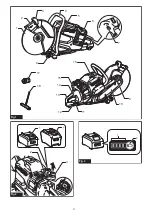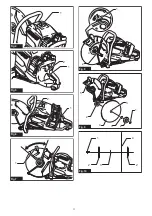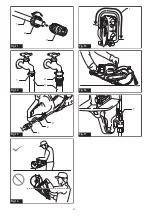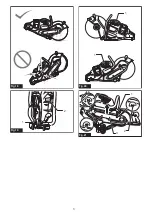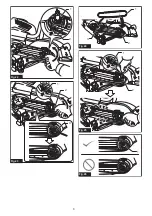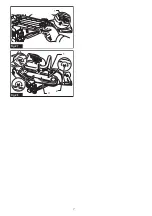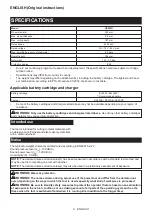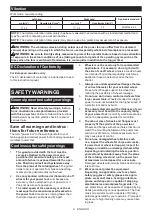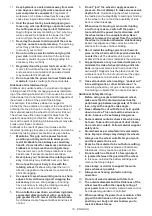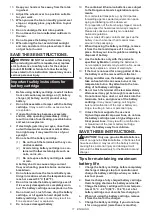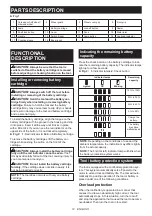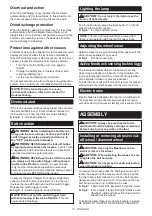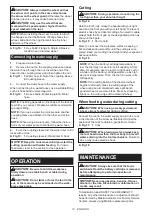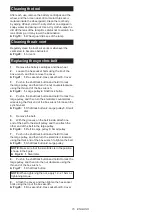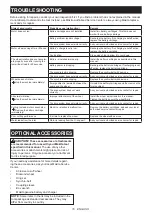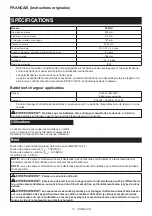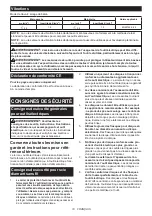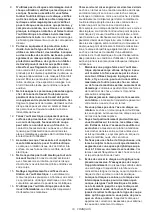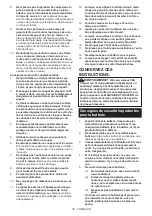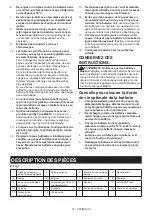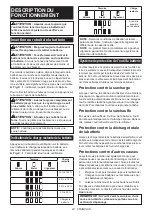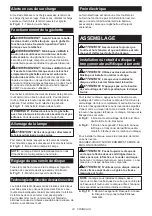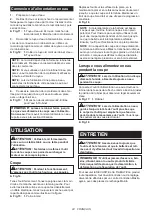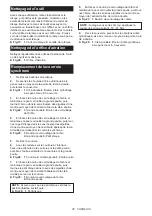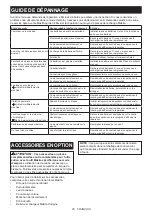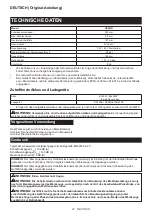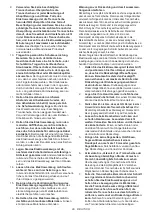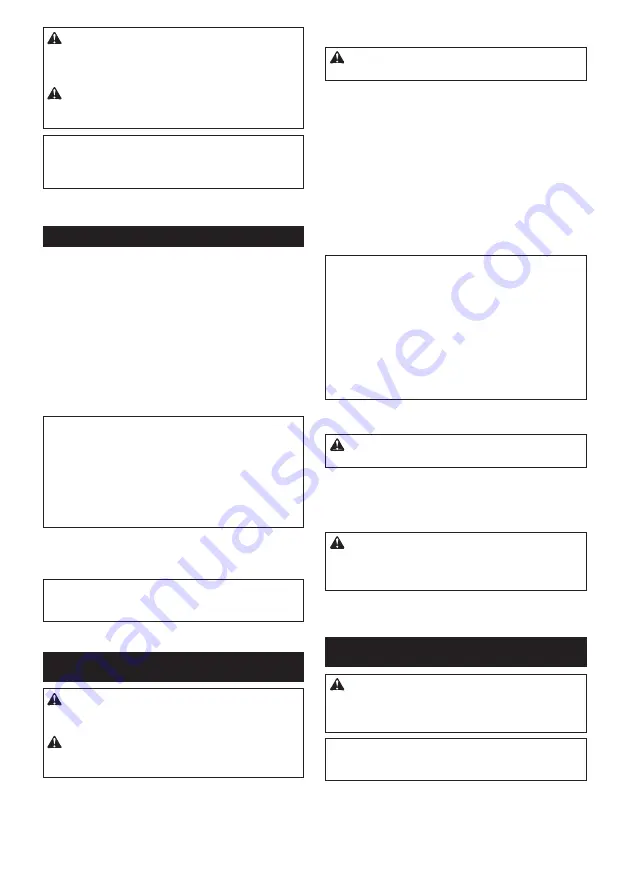
14 ENGLISH
CAUTION:
Always install the wheel so that
the arrow on it points in the same direction as
the arrow on the wheel guard.
Otherwise the wheel
rotates in reverse, it may cause personal injury.
CAUTION:
Only use the wheel that are
marked with a speed equal or higher than the
speed marked on the tool.
NOTE:
When installing the wheel, be sure to attach
the flanges so that the flat side of flange faces the
wheel, and attach the ring that matches the inner
diameter of the wheel.
►
Fig.10:
1.
Hex bolt
2.
Flange
3.
Ring
4.
Abrasive
cut-off wheel / diamond wheel
Connecting to water supply
1.
Prepare a water hose.
2.
Remove the nut on the coupling sleeve and pass
the water hose through the nut. Insert the end of the
hose into the coupling sleeve and then tighten the nut.
►
Fig.11:
1.
Water hose
2.
Nut of the coupling sleeve
3.
Coupling sleeve
3.
Connect the water hose to the water supply.
When connecting to a water faucet, use a suitable fitting
such as hose band or water tap joint.
►
Fig.12:
1.
Hose band
2.
Water tap joint
3.
Water
hose
NOTE:
The fitting depends on the shape of the faucet
to which you connect. Prepare a suitable commercial
-
ly-bought fitting.
NOTE:
If you use a water tap joint, prepare another
coupling sleeve and attach it to the other end of the
hose.
NOTE:
When using a water pump, follow the instruc-
tions of your water pump to connect the water hose.
4.
Push the coupling sleeve into the water inlet until it
locks with a click.
►
Fig.13:
1.
Coupling sleeve
2.
Water inlet
3.
Cock
NOTICE:
Keep the cock closed until you start the
cutting operation with water feeding.
For how to
feed water, refer to the section for the operation.
OPERATION
CAUTION:
Be sure to hold the workpiece
firmly down on a stable bench or table during
operation.
CAUTION:
Do not twist or force the tool in the
cut, or the motor may be overloaded or the work-
piece may break.
Cutting
CAUTION:
During operation, do not bring the
tool higher than your shoulder height.
►
Fig.14
Hold the tool firmly. Grasp the handle with your right
hand and the front grip with your left hand. To prevent
electric shock by accidental cutting of an electric cable,
always hold the front grip by the designated portion as
shown in the figure.
►
Fig.15:
1.
Part to hold
Move the tool over the workpiece surface, keeping it
flat and advancing smoothly until the cutting is com
-
pleted. Keep your cutting line straight and your speed of
advance uniform.
►
Fig.16
NOTE:
When the battery cartridge temperature is
low, the tool may not work to its full capacity. At this
time, for example, use the tool for a light-duty cut for
a while until the battery cartridge warms up as high
as room temperature. Then, the tool can work to its
full capacity.
NOTE:
If the cutting action of the diamond wheel
begins to diminish, dress the cutting edge of the
wheel using an old discarded coarse grit bench
grinder wheel or concrete block. Dress by pressing
lightly on the outer edge of the diamond wheel.
When feeding water during cutting
CAUTION:
When using a wet-type diamond
wheel, always feed water during cutting.
Connect the tool to the water supply and turn the cock
in the direction of the arrow as illustrated. Adjust the
position of the cock to obtain a gentle flow of water.
►
Fig.17:
1.
Cock
CAUTION:
When feeding water, always keep
the tool head lower than the tool body to prevent
water entering into the tool mechanism.
Failure to
do so may cause electric shock.
►
Fig.18
MAINTENANCE
CAUTION:
Always be sure that the tool is
switched off and the battery cartridge is removed
before attempting to perform inspection or
maintenance.
NOTICE:
Never use gasoline, benzine, thinner,
alcohol or the like. Discoloration, deformation or
cracks may result.
To maintain product SAFETY and RELIABILITY,
repairs, any other maintenance or adjustment should
be performed by Makita Authorized or Factory Service
Centers, always using Makita replacement parts.
Summary of Contents for CE001G
Page 2: ...2 17 1 2 4 3 6 5 16 15 14 12 11 9 13 10 18 7 8 Fig 1 3 1 1 2 Fig 2 1 2 Fig 3 ...
Page 3: ...3 1 Fig 4 1 2 Fig 5 2 1 Fig 6 1 Fig 7 1 2 3 4 Fig 8 3 4 2 5 2 5 1 Fig 9 2 3 4 1 2 Fig 10 ...
Page 4: ...4 1 2 3 Fig 11 1 2 3 Fig 12 1 2 3 Fig 13 Fig 14 1 Fig 15 Fig 16 1 Fig 17 ...
Page 5: ...5 Fig 18 1 2 Fig 19 1 1 Fig 20 1 2 3 Fig 21 ...
Page 6: ...6 1 2 Fig 22 1 2 3 Fig 23 1 2 3 Fig 24 1 2 Fig 25 1 Fig 26 ...
Page 7: ...7 1 Fig 27 1 2 3 Fig 28 ...
Page 106: ...106 ...
Page 107: ...107 ...


